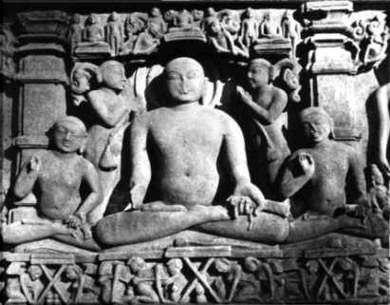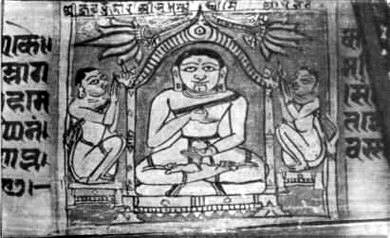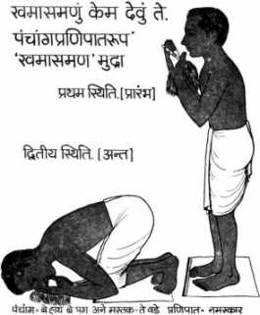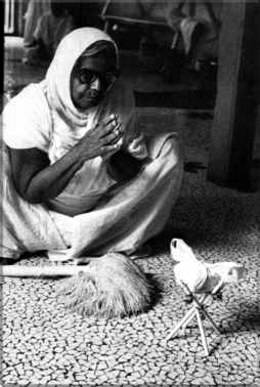Avashyaka III, Vandana
"Vandana" stands for salutation. The third Avashyaka may be described as a ritual of repentance combined with a "ritual of approach"[1]. However difficult the text may be, it gives a good impression of early ritualism.
At the end of the day the junior monk (student) approaches the senior (teacher) and subsequently takes his leave. The action is described, not as coming and going in the general sense, but as entering and leaving the uggaha or prescribed range, a circle with a radius of a man's height round the teacher and an area which must be respected by visitors. It seems that Vandana is a ritual of repentance taking place between student and teacher who greet each other with due deportment.
A special place is assigned to the two words nisihi[ya] (meditation, mental attitude appropriate to the place entered) and avassiya (obligation arising and justifying departure). These are monastic formulas for approach and leave-taking (also used in other contexts) and form the nucleus of the approach ritual:
The monk has to say "n." when coming and "a." when going. However, the two words n. and a. are not incorporated into Vandana in a clear manner. Among problems like these there are some which strike even the casual reader [2].
In the commentaries specific reference is made to the rao-harana or broom. Originally, this was probably a simple implement used, for example, in order to gently sweep away small insects on the ground before putting down some object. In the course of time, its form became somewhat artistic and its use formalized and symbolical. We do not know whether this requisite already belonged to the original ritual or was incorporated later on. Here we have included four illustrations demonstrating the use of the broom (rao-harana). In illustrations 1 and 2 there is a situation which resembles the Vandana ritual in a general way, and in illustration 3 we see two illustrations from a modern manual, actually describing part of the Avashyaka ritual as it should be practised by the layman. Illustration 4 is a small scene showing a Jaina nun performing her daily ritual.
We add in square brackets six answers of the teacher as given in the commentaries, and in parentheses three other additions, also taken from the commentaries. Paragraphs 5 and 6 can also be taken as questions. Refer for the formulaic ending of the text (tassa khama-samano...) to the corresponding passage in Samayika (Avashyaka I). The Prakrit text consists only of the formulaic dialogue between student and teacher, and even the Sanskrit commentaries do not supply an exhaustive description of the ritual.
|
[1 and 6]: In principle, both teacher and student should have the benefit of "comfortable meditation". -- [8]: padikkamami (I repent) cannot be connected with the preceding or following word(s) in a satisfactory manner. -- [9]: "Irreverence" is an important concept. Our text describes irreverence in general terms, but it mentions the well-known list of thirty-three different forms (thus the student should not give impolite answers to his teacher, should not criticize him etc.). The opposite of irreverence is "deportment". Here too we get a list, viz. ten positions including avassiya and nisihiyaas discussed above.
Illustration 1: Sculptured slab showing the motif of the acarya or teacher. Jaina temple in Northern India (A.D.950-1050). Three acaryas (preaching gesture formed by the right hand, book kept in the left hand) are surrounded by ordinary monks or students (two in the main group, eight further down). Both, acaryas and monks are shown with short brush-like brooms.
|
Illustration 2: [3] Miniature painting (A.D.1295). An acarya with two monks. The broom of the acarya is not shown. |
| Illustration 3: [4] Modern manual. Two postures in the sequence of the Avashyaka ritual. |
| Illustration 4: [5] Jaina nun with her broom. She pays her respects to the small stool to her left which is a symbol of her teacher. |
 Prof. Dr. Klaus Bruhn
Prof. Dr. Klaus Bruhn



